This article was published in Scientific American’s former blog network and reflects the views of the author, not necessarily those of Scientific American
Right now, Hunting Monsters only exists as an ebook. If you’re at all like me, this might be something of a disappointment, since I don’t get much satisfaction from ebooks and think of them more as badly formatted word documents, not as books at all.
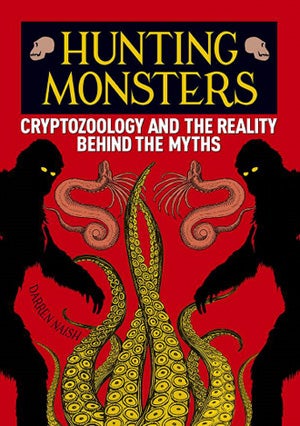
Front cover of Naish (2016). I like it.
Anyway, if it sells well enough in digital format, we’ll then be releasing a hardcopy version. The good news is that the ebook version is criminally cheap (£2.39, US$3.45). Also, remember that you don’t need a kindle to read it – you can download a kindle app, for free, for any device, and thereby read it on your smartphone or PC or whatever.
On supporting science journalism
If you're enjoying this article, consider supporting our award-winning journalism by subscribing. By purchasing a subscription you are helping to ensure the future of impactful stories about the discoveries and ideas shaping our world today.
There are a large number of books out there on cryptozoology already, so what’s special about this one? Hunting Monsters is a sceptical, pro-science take on cryptozoology; something along the lines of Binns (1984), Campbell (1986), Radford & Nicklin (2006) and Loxton & Prothero (2013). But that doesn’t mean that it’s a vicious debunking that leaves us all sad and disheartened – we can get something positive out of this; read on.

Hugh Gray's Loch Ness monster photo is not a swimming dog or a giant salamander or worm-like animal, but a swan with a submerged head. This explains why it's so white. Look carefully and you can see the wings, tail and ankle joint. Swan image by Peter Gray (no relation... I presume!), from Naish (2016).
A reasonable amount of novel investigation of cryptid sightings and images is recounted. Classic water monster episodes like the Daedalus and Valhalla accounts and the Sandra Mansi photo are discussed in view of recent evaluations, and I’ve also included much of the new work on lake monster images released by Dick Raynor. Without giving too much away, I want to say that the famous Hugh Gray Loch Ness monster photo of 1933 is not a swimming dog, or a salamander-like beast, or giant anachronistic Tullimonstrum… but a swan. Yes, a swan. And the infamous Peter O’Connor photo of 1960 – the one that depicts what looks like an inflated plastic bag with a stick for a head – has proved to be the inverted hull of a kayak called a Tyne Prefect. You can even see the base of the rudder support!
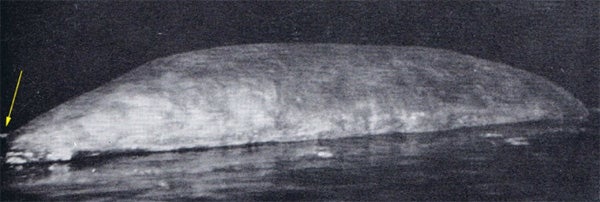
Cropped version of the O'Connor Loch Ness monster photo - note how the far left part of the image (normally cropped out!) looks weird for what's meant to be part of an animal's body. It's a good match for the corresponding part of an inverted kayak (see Dick Raynor's study here).
And then there are my evaluations of Rilla Martin’s Ozenkadnook tiger photo, various of the key yeti and bigfoot accounts, a critical appraisal of the kraken (no, it is not the same thing as Architeuthis), the St Augustine blob and other sea monster carcasses, and more. I even obtained and read Jonathan Whitcomb’s ropen book…

Rilla Martin’s 1964 Ozenkadnook tiger photo - shown at left - has always been enigmatic and difficult to interpret. What's with the tall shoulders and pale stripes? (as per the interpretation at right, by Darren Naish). See Naish (2016) for current thoughts.
While previous authors have focused on the ecological and morphological problems attached to the superstar cryptids (for example: could a beast the size of Nessie really make a living in Loch Ness?; how could a creature like bigfoot evade detection in modern North America?), few have discussed the fact that cryptozoological hypotheses invoke very specific models pertaining to evolutionary history.
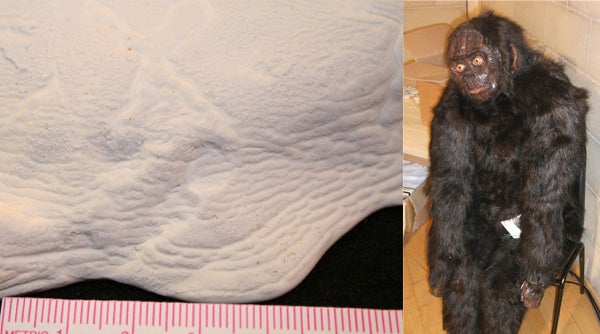
In recent years, some apparently good evidence for bigfoot has dissolved under scrutiny. Alleged dermal ridges have proved to be artifacts of the plaster-pouring process, as demonstrated by Matt Crowley (image of plaster ridges by Matt Crowley, used with permission). And claims that the lustrous pelt and realistic muscle tone of 'Patty' can't be replicated by a suit are highly questionable - look at the realistic tone and texture of the obviously fake suit on the right (photo by Darren Naish).
What’s notable is that, while cryptids themselves are posited as novel, exciting elements of the fauna, the evolutionary scenarios required to allow their existence virtually always involve novel, unprecedented events for which there is, alas, no evidence. The giant long-necked seals of the cryptozoological literature require that certain (unknown) pinnipeds evolved radical ecological, morphological and behavioural novelty; a view of bigfoot or the yeti as a giant, bipedal pongine requires that our views on the evolution of hominid bipedality and anatomy be substantially revised; arguments that the almas (or almasty or almasti) is a remnant Neanderthal are contingent on the idea that Neanderthals underwent radical change for which we have no evidence; and so on and on and on. Cryptozoologists have thought about this stuff a lot and written about it as well, but it has mostly evaded sceptical evaluation (for previous coverage see Conway et al. 2013).
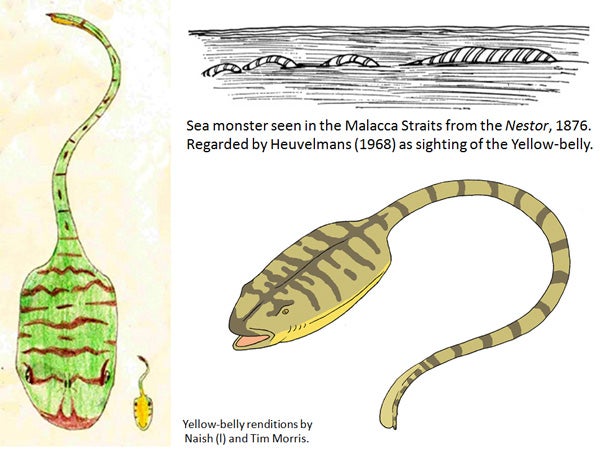
Sea monsters and other mystery beasts - the creature shown here is Heuvelmans' 'Yellow-belly' - have taken on a life of their own ever since cryptozoologists have devised morphological configurations and evolutionary histories for them. But isn't this all a house of cards? Compare 'Yellow-belly' with the eyewitness accounts Heuvelmans based it on.
And what of the interplay between cryptozoology and creationism? I say stuff about that in my chapter on the mokele-mbembe and ropen (Naish 2016).
A new frontier: cryptozoology as culture
However, I hope that Hunting Monsters is seen as more than a mere curmudgeonly debunking, or as yet another heavy-handed sceptical smackdown. One of my arguments, made repeatedly throughout the book, is that cryptozoology is culture. Even if cryptids don’t exist – in the corporeal, biological sense of the term – they still exist in the nebulous sense of their having a place in the psychological landscape, and this remains a fascinating issue worthy of further study.

Blu Buhs (2009), required reading as goes the cultural context of bigfoot.
People ‘see’, describe and report the creatures they do because they interpret their recollections, sightings and encounters within the cultural framework in which they were raised. It is, so it seems, an inevitable consequence of being human that we imagine large, frightening creatures to lurk beneath the surface of the water, or human-shaped beasts in forests and other wild places.
There’s also a case to be made that people of a given subset will be more inclined to investigate or believe in mystery animals than others: this topic is explored at length in Blu Buhs (2009).
Indeed, the fact that belief in these creatures will not die – despite a compelling and impressive lack of evidence – makes it seem that they’re an almost immutable part of our psyche. Is there, then, really some ingrained need in humans to imagine, believe in, or see monsters? I don’t know the answer, but I think it’s a question worth asking and investigating.
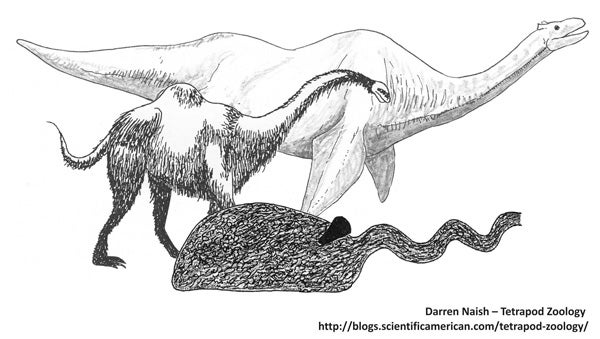
Which Loch Ness monster would you like to believe in? We most certainly do not see consistent descriptions of a single biological entity.
Distinct from but linked to this apparent cultural role of cryptozoology is our ability to perform as witnesses and ‘data recallers’. It’s no secret that people generally perform very badly when it comes to describing and recalling observations, especially those made fleetingly or when under stress. And sceptics of cryptozoology often point to the field’s over-emphasis of the value of eyewitness data as one of its primary flaws (Loxton & Prothero 2013). How we perform as witnesses and recallers and why we fail or succeed when we do is another fascinating subject – and I say that it’s linked to the cultural role of cryptozoology because a case can be made that our preconceptions and biases are linked to cultural and societal archetypes, memes and concepts.
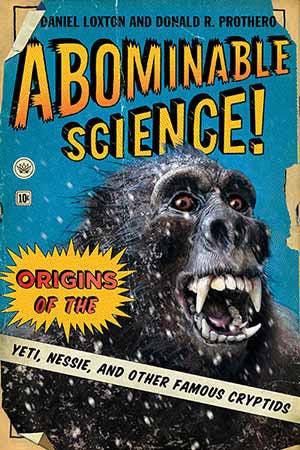
Standard reading on cryptozoological scepticism: Loxton & Prothero (2013).
We’re at an early stage in understanding this stuff. Or, at least, those of us who aren’t experts in it are at an early stage. What I’m saying – by now it’s probably clear – is that, while bigfoot and Nessie and so on might not be ‘real’, they’re likely ‘real’ enough, culturally and/or psychologically, to be significant to us. I think that that’s important. We’re calling this whole subject ‘post-cryptid cryptozoology’, and I hope that Hunting Monsters is perhaps epiphanic on this front to at least some of its readers.
So there we have it – long-time readers of Tet Zoo will know that this book represents the culmination of an evolving set of thoughts and hypotheses.
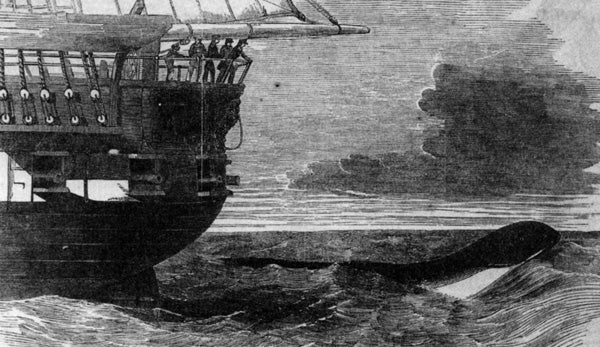
The Daedalus encounter of 1848 remains one of the most pivotal and influential of sea monster reports. Was it actually a misidentified rorqual, as argued by Galbreath (2015)? This is more compelling when you look at Lieutenant Edgar A. Drummond's sketch.
And finally...
As always with anything written by humans, there are a few errors that are making me cross. In a discussion of the Daedalus sea monster sighting, I say that the beast had no neck, and then immediately go on to say that its mane was located some way along… its neck. There’s also a contradiction as goes how the Daedalus monster is treated – it’s a skim-feeding Sei whale at one point (as per Gary Galbreath’s 2015 article) and an unresolved enigma at another. Whoops. And there are a few dumb typos and incorrect terms, as there always are. I hope you can forgive these transgressions.
For previous Tet Zoo articles relevant to the issues covered here, see...
Refs - -
Binns, R. 1984. The Loch Ness Mystery Solved. W.H. Allen & Co, London.
Blu Buhs, J. 2009. Bigfoot: the Life and Times of a Legend. University of Chicago Press, Chicago.
Campbell, S. 1986. The Loch Ness Monster: The Evidence. The Aquarian Press, Wellingborough, UK.
Conway, J., Kosemen, C. M. & Naish, D. 2013. CryptozoologiconVolume I. Irregular Books.
Loxton, D. & Prothero, D. R. 2013. Abominable Science! Columbia University Press, New York.
Naish, D. 2016. Hunting Monsters: Cryptozoology and the Reality Behind the Myths. Arcturus, London.
Radford, B. & Nickell, J. 2006. Lake Monster Mysteries. University of Kentucky Press, Lexington.